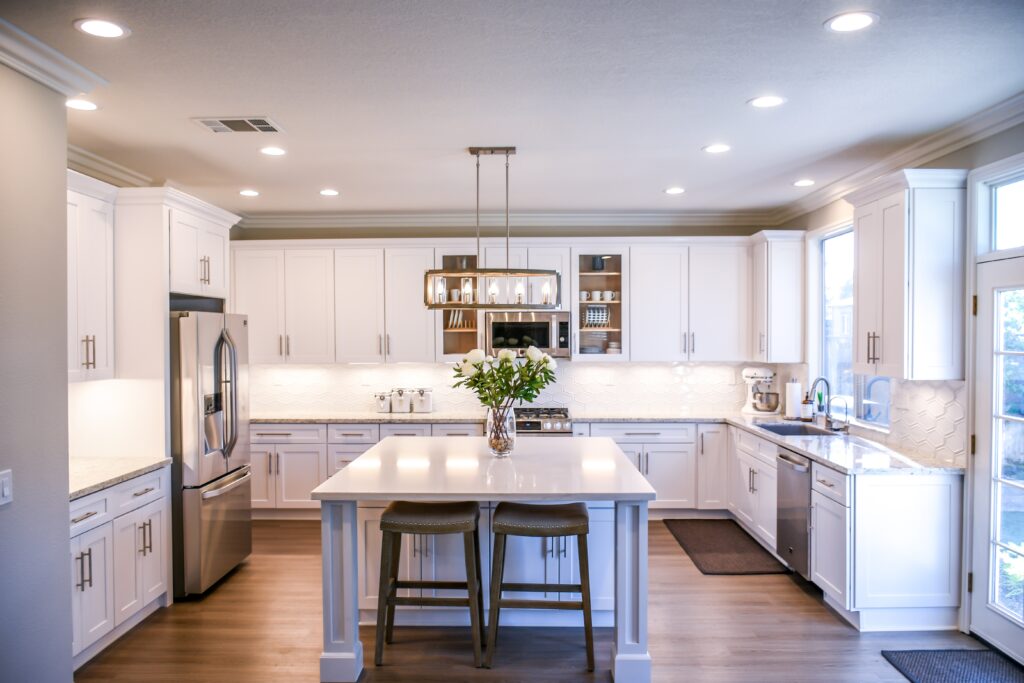Discover the best kitchen flooring alternatives for you, from hardwood to vinyl to tile.
There are numerous aspects to consider while selecting a kitchen floor: how frequently do you cook? Do you have a flexible floor plan? What is the most long-lasting?
We’ve eliminated the guesswork by selecting four flooring options that perform well in kitchens.
Hardwood Kitchen Flooring Is Ideal When:
- You don’t want your kitchen to become out-of-date over time.
- Your floor layout is open.
- You are looking for longevity.
Hardwood flooring, with its unparalleled warmth and visual appeal, is an excellent choice for a timeless design. It will also provide you with a decent return on investment if you ever decide to sell your property. Another advantage is that hardwood works well in kitchens and living rooms if you have an open floor plan, providing a warm, unified aesthetic.
Hardwood is also:
- Highly durable, withstanding decades of use
- Low-maintenance
- Moisture-resistant if you choose a prefinished type
For hardwood flooring, you’ll have two options: solid wood strips or engineered wood planks. Engineered wood has a natural wood veneer that is supported by layers of less expensive plywood. It’s the best option for kitchens because it has dimensional stability, which prevents the flooring from movement caused by variations in humidity and temperature, which is a common issue in kitchens.
Engineered wood costs between $3 and $14 per square foot.
Engineered wood installation costs between $4 and $9 per square foot, depending on the job’s intricacy.
Vinyl Kitchen Flooring Is Ideal When:
- You cook a lot.
- You want the easiest-to-maintain floor.
- You’re on a tight budget.
Sheet vinyl is the softest flooring option and is considered resilient flooring. If you cook frequently, the cushioning makes it easy on your feet and reduces muscular strain. Also, if you (or a family member) is a klutz who drops stuff, sheet vinyl is far more forgiving. There will be less breakage. You can also easily clean sheet vinyl flooring. It is entirely waterproof and stain-resistant.
However, there are certain drawbacks to this option. Seams may exist in your kitchen, depending on its size and arrangement. The normal width of vinyl flooring is 12 feet. If your kitchen is wider than that, you will almost certainly have seams. They can admit moisture into the subfloor and trap dirt if they are not tightly connected.
Sheet vinyl, on the other hand, merely requires sweeping and mopping. You can’t get much lower upkeep than that. If the softness of vinyl flooring appeals to you, consider a cushioned version backed with a layer of foam. However, the added cushioning makes it difficult to keep seams tightly bonded over time. If the seams separate, moisture and dirt may become trapped.
Sheet vinyl is available in a variety of colors and designs. Thicker vinyl can have a textured surface, and some styles resemble ceramic tile and natural stone. Textured vinyl has the advantage of providing traction. When wet, vinyl can be extremely slippery.
A nonpermanent wear layer on vinyl flooring also helps to resist scratches and scuff marks. The wear layer on the top brands is guaranteed for 10 to 15 years, and good quality vinyl should endure for 20 years.
1 to 2 dollars per square foot
Sheet vinyl installation costs between $3 and $7 per square foot.
A word of caution: don’t mix vinyl and linoleum. Linoleum is comparable, although it is not as durable or soft.
Porcelain Kitchen Tile Flooring Is Ideal When:
- You want the toughest flooring.
- You like the look of stone.
- You want low maintenance.
Porcelain flooring tile, a type of ceramic tile, is the most durable. It is burned at high temperatures, resulting in an exceptionally hard, stain-resistant tile that is resistant to moisture. In fact, it is so durable that it may be used outside in almost any temperature. Porcelain tile, like regular ceramic tile, is available unglazed or glazed. Unglazed versions take on the color of the clay mixture, giving them naturally earthy tones.
Glazed tiles, on the other hand, have a glass-like coating that can be made in almost any color and can mimic the look and texture of real stone at a much lower cost.

Ascertain that the porcelain tiles are slip-resistant as defined by the Americans with Disabilities Act. The marking should be visible on product information or packing materials.
Price range: 50 cents to $15 per square foot
Installation costs between $4 and $32 per square foot.
Cork Kitchen Flooring Is Ideal When:
- You want an eco-friendly choice.
- You want a softer floor than wood or tile.
- You want slip-resistance.
Cork is created from tree bark that is gathered every eight to ten years and is environmentally friendly. Harvesting is regulated in countries that produce it to ensure future availability.
There are a few advantages. Cork’s waterproof and compressible cellular structure makes it an ideal choice for comfort and moisture resistance. It is available in 12-inch-by-12-inch tiles and one-foot-by-three-foot planks, each with a unique swirl and speckled grain pattern. Furthermore, the naturally textured surface prevents slippage.
Cork, on the other hand, requires upkeep. This flooring should be resealed every three to four years to protect it from scratches and to keep moisture out of the crevices between tiles. Natural wax and polyurethane are effective sealants. To keep it green, choose water-based polyurethane that is nontoxic or has a low volatile organic compound content.
Cork tiles cost between $3 and $6 per square foot.
Cork planks cost between $4 and $8 per square foot.
Installation costs between $2.50 and $6 per square foot.
To see other material construction, please see here.
To know other construction guides, tips, and methodology for beginners, veterans, and contractors, please see here.

